
Gard Bass Saxophone Wheelie 108-WBFSK
Price: Ranges greatly. You need to shop around. A LOT. You also need to factor in what shipping is going to cost given where you live.
That’s why I chose Thomann Music in Germany. They had the best shipping price and overall cost. I paid $415.00 US for the bag, plus only €88 ($97.42 US according to xe.com) for the shipping. The bag arrived in about 2 days via UPS.
Some shops in the US wanted $15 less for the bag, but were going to charge me upwards of $300 US shipping to Canada. ![]()
Date of manufacturing: Circa 2024
Date of review: August 2024
Horn it was bought for: H. Couf Superba I bass – stencil of Keilwerth Toneking Special from 1983
Horns these rolling gig bags are designed for: Vintage American style, AKA long wrap, bass saxophones like those made by:
- Buescher
- Conn
- Pan American
- Orsi
- Keilwerth
- Any stencils of the brands mentioned above
- Any of the countless, ultra-cheep Jinyin horns that came stencilled under a multitude of names and were so prevalent just over a decade ago.
But wait, there’s more: According to Thomann Music, even French, AKA, short wrap horns fit in this rolling gig bags. Really? (More on that below)
If you own vintage American style bass of any stripe, and it needs a replacement case, you are deeply screwed. There are currently no practical, commercial options available to you.
Sure, you can get a plywood case from Allied from your tech, but the cost of them have climbed through the roof. And their practicality? In my case, not at all that much better than the OEM case I was looking to replace. (And if you know how much space a Volvo wagon has, you’d know how big this Keilwerth bass case actually is!)
Why I needed a replacement case, and the steps I took
I currently play bass in a saxophone ensemble that rehearses weekly in a community that is 20 miles down the highway from where I live. Given my screwed up back, I needed something that didn’t add another 40 lbs. to a 20 lb. instrument, and didn’t require me to wrangle something nearly the size of a twin size bed, around the tight angles of my home.
As I started doing research into replacement case options for vintage American-style horns, I grew deeply disappointed. In short: there were almost none.
Sure, I could get a custom case made—been there, done that—and a friend and I were actually exploring that option. However, I remember the work involved for Bruce when he made the case for my True Tone, and quite frankly, I value my friendship with Rob too much to strain it with something as inconsequential as a saxophone case.
I reached out to various case manufacturers from Europe to Asia, but none were interested in filling the niche that Fazley left vacant when they ceased sales of their BAS-SB100 bass case.
Therefore, with no true case options available, I did what I never thought I would do: I explored gig bags. However, as I soon found out, even gig bags for long wrap bass saxophones were not a common commodity. In short: there are almost none of those either. (Cronkite makes theirs for short wrap bass saxes. I wrote the company, still waiting for a reply to see if they will make them for long wrap horns again.)
All this research into bass sax cases/bags led me to what is currently the best, and quite frankly only real portable transportation option for your vintage American style bass saxophone: those made by Gard. Gard offers both a gig bag, as well as the wheelie bag that I ended up ordering.
Specs according to Gard
108-WBFSK
Gard Bass Saxophone Wheelie
Synthetic with Leather trim
Stylish and sturdy saxophone wheelie bag with a telescopic handle to allow easy adjustment to your height.
- Designed and measured to fit One Bass Saxophone.
- Equipped with Gard’s patented mid-bag suspension system to provide ultimate protection.
- Convenient side pockets to keep your belongings safe and organized.
- Can be carried as a backpack.
- Color – Black
Product Details
Inner Dimensions
57 x 20 x 17.5 (in Inches)
145 x 53 x 45 (in cms)Outer Dimensions
59 x 22.5 x 19.5 (in Inches)
149 x 57 x 49 (in cms)Front Pocket Dimensions
NASide Pocket Dimensions [4]
NAWeight
8 Kgs / 17.64 Pounds
PREMIUM COMPONENTS & WORKSMANSHIP
- 1200 denier water-repellant ballistic polyester fabric with contrasting Burgundy cowhide trim.
- Solid brass electroplated fittings.
- Premium YKK zippers.
- Printed logo.
- Integrated Rain Cape.
EXCEPTIONAL INSTRUMENT PROTECTION
- Patented Mid-Bag Suspension System and Full-Perimeter (omni-directional) impact protection, with GARD’s unique Harmonized Material Integration methodology for impact absorption, interior contact isolation and stiffness exactly where needed throughout the bag.
- Every handle and strap ring attachments is stitched, double-riveted, and canvas reinforced for extra safety.
All our Wheelies have a front kick-stand that prevents the bag from toppling over due to weight of the instrument.This bag has been hand crafted from carefully sourced premium materials that are tested for harmful chemicals and strict quality parameters to enhance longevity.
COMFORT AND CONVENIENCE
- Soft-touch Leather Handle adjusts comfortably to your hand.
- 2” Padded Shoulder Strap is included for your comfort.
- Leather Luggage tag is included for your convenience.
- Organizer Accessory Pocket helps you keep your stuff safe and sorted when you’re on-the-go.
CARE INSTRUCTIONS
- Remove dirt with a soft cloth or brush.
- Use mild soap and water to spot-clean your bag with gentle circular motions.
- Allow the bag to air dry at room temperature.
- Never use heat to dry leather.
- Apply leather conditioner on leather parts, if you want.
We do not mass-produce any of our series.
This means that all our bags are made with a bit more care and love – and you can see that in the finished product!
GARD BAGS LIMITED CONSUMER WARRANTY
In those rare cases where there is a problem due to manufacturing defect in our materials or workmanship within warranty, we will repair or replace the bag (where it cannot be repaired) at our option. Our guarantee does not cover product damage from normal wear and tear or from improper handling. Accidental damage is not covered under warranty nor its consequences, such as damage to the contents of the bag or wheelie. This warranty does not affect any additional rights you may have under the laws of your jurisdiction.
Replacement spare parts are available at a nominal cost. Connect with us to order spare parts.
Video demo of a wheelie bag
Unfortunately there is no demo of the 108-WBFSK for bass, but I did find this one for the bari wheelie that explains its features.
Note what Gard calls the 108-WBFSK
In their description on their website, Gard is very careful not to call the bass sax wheelie a case. Nor do they call it a gig bag like their 108-MSK is.
So what is it? To me it is really just a gig bag on wheels. The telescopic handle and wheel frame certainly gives the bag more stability than a conventional bag—and likely more than what you find in the 108-MSK as well. The trade off however, is the added weight that these features add.
108-MSK Gig Bag |
108-WBFSK Wheelie |
3.40 Kgs / 7.50 Pounds |
8 Kgs / 17.64 Pounds |
As someone who has only ever used conventional cases, this gig bag on wheels is definitely a different animal. There are a lot of both pluses and minuses when you consider the purchase of one of these. Below are my personal experiences and opinions regarding the 108-WBFSK. I offer these up for anyone considering the purchase of one for the vintage American style bass saxophone.
My personal experience with the Gard Bass Saxophone Wheelie
I ordered my Bass Saxophone Wheelie by Gard in May this year. At the time of writing I have had and used the bag for nearly 3 months now. It took me a bit to figure out the logistics of using it; organizing my accessories; and then a week of going to rehearsals to have my workflow all organized. By week 2 of taking it to rehearsals everything worked like clockwork.
Accessory Storage
The wheelie bass bag has 4 generously-sized accessory pockets on the outside. Two located on each of the wide sides. There is ample room for storing things like the neck, MP, reeds, and sundry other accessories.
Since the bell, bow, and bore of a bass is so large, it is never a good idea to put the neck or MP down it for storage. MPs and necks have been known to get lost down the bell of bass saxophones. (That’s how I got the Riffault bass MP when I bought the Couf. It had fallen down the bell and was in the bow.) ![]() This is why the pockets are essential for storing accessories.
This is why the pockets are essential for storing accessories.
However, BE CAREFUL. These pockets are not padded, and depending on how you transport your bass—and the position you transport it in—whatever you place in the pockets can get damaged.
Bass saxophone necks are wickedly expensive if you have to replace one with a Gloger. This is especially true if your horn has what’s commonly called a sink trap neck. These are found on Keilwerth, and some Conn 14M bass saxophones. (Gloger calls these “knee” on their website, and as you can see, this feature doubles the price of the replacement neck.)
To protect my Keilwerth’s sink trap neck, I store it in a Rubbermaid storage container that fits perfectly into the larger storage pocket. I store the MP in the neck storage pouch that comes with the wheelie rolling gig bag, since it is designed for straight necks and is too small for the sink trap neck style. The MP in the pouch then get stored in the smaller, top storage pocket.
Why I put labels on the bag
 From the photos you can see that I have labelled my bag and even the Rubbermaid container. You might be wondering why I did this. A few reasons really.
From the photos you can see that I have labelled my bag and even the Rubbermaid container. You might be wondering why I did this. A few reasons really.
- It is really easy to misplace stuff, or not store stuff in the right place. This is especially true when you’re not in your usual routine, or when things are especially hectic—such as when cleaning up after a show. Having labels on stuff makes sure things all things are accounted for, and are where they are supposed to be.
- If the horn has to go to the shop to get work done, this way David knows what goes where, and he too knows where all the parts are, and what they are.
- My back was seriously screwed up during an accident at work 3 decades ago, and since then I have lived with chronic back pain. To help me out, members of our sax ensemble assist me carrying the bass up and down the 2 flights of stairs at our rehearsal space, or will often help me load it into the car.
- Having the bag labelled TOP is important because you never want to lay the horn on its right side while in its bag While having it stand up is ideal, laying it down is necessary if you are transporting it by car. By labelling it TOP, no one is going to accidently lay the horn on the wrong side.
I used Day-Glo yellow gaffers tape for the labels. Yes, it is visible in black light. (Something we noticed at our last outdoor performance a week ago when we finished after dark, and the black lights on the bandstand were on.
Travel by car
Before I ordered this gig bag on wheels, I tried to read all the reviews of it, but nothing I read was from people who used it in their cars. Most people who owned this model bag travelled via public transit, and carried the horn upright.
Travelling by car though requires you to be able to lay the horn down like you would a conventional case, with the horn laying on its left side. To protect your horn a bit from the bumping and jarring it receives from the trip, I always do the following:
- Place foam under any case the horn travels in.
- Cork down the low C, B, & Bb keys.
- Reduce the rough ground the bag gets pulled on.
- Lift it over curbs etc.
Doing these few things seems to reduce the leaks the horn has developed. That said, this is my Keilwerth. It is much less prone to leaks than the Buescher was. It is quite possible that players of vintage Conns and Bueschers etc. might have quite different experiences in the leaking department. ![]()
What I like about the gig bag on wheels
- It is much more portable than the OEM case that comes with the Keilwerth bass saxophones. The stock case is heavy, long, awkward, and an absolute bitch to maneuver down the narrow hallway that runs 40′ to and from my studio, and has 2 extremely tight, right angle turns.
- The double wheels on each side are fantastic. IMHO, wheels on cases are an absolute must for any saxophone over 15 or so lbs.
- The telescopic handle like you find on luggage these days is extremely practical. You can pull it behind you; push it in front you. Regardless of your height, the handle extends for your comfort.
- The ample storage pockets are great for everything you need to store and then some.
- The kickstand is fantastic. It prevents the horn from falling over when it is standing up, but also slides in when it is not needed.
- The protection offered appears to be OK. So far I have taken my horn to about 6 or 7 rehearsals. Each road trip is about 40 miles in total. After about 280 miles of combined highway, country road, and city driving, the horn doesn’t appear to play any differently than it did before I put it in the Gard wheeled gig bag. That said, the proof will come when the Couf goes to David for some much-need pad replacement in September. It will be interesting to see if the horn is the same or worse than it normally is when he works on it at my place.**
- It takes a bit of getting used to, but I do kind of like the front-loading feature of the gig bag on wheels. Both taking it out, and putting it away are in some ways easier, but also has its downsides. (See below for more info.)
- The bag takes up less real estate in a crowded practice space or studio than a conventional bass case that has to lay on its side. Because as we all know, bass cases are pretty damn large.

- The build quality is really surprisingly good. I didn’t know what to expect, but it was clearly made with care and precision.
** I should also mention that whenever I drive with horns in the back of my station wagon—and this is especially true when I drive with a bass in the car—I drive like I did when I had a spinal cord injury patient in back: Gradual acceleration and deceleration. Avoid bumps as much as I can. Leave as much space around me as I can to allow for evasive maneuvers. (In the insanity of Lower Mainland traffic that is getting to be a real art form.) ![]() Defensive driving + skills if you will.
Defensive driving + skills if you will. ![]()
What I don’t like about the gig bag on wheels
- The location of the backpack strap is useless. It makes the bag so high it hits door frames and everything else. Notice I also had to squat to be able to get it on my shoulders.
- There is no real carrying handle on the bag if you want to carry it like you would a conventional case. The one handle located on the front side, runs horizontally. Not practical for carrying the wheeled gig bag.
- The front side of the bag, what I am calling a tongue, needs to be unzipped completely when you put in and take out the bass from the wheelie bag. In my studio with a carpeted, clean floor that’s fine, but when out at a rehearsal or show, the chances of having to place this tongue on a dirty surface are pretty good if something to lay it on it on, like a chair, is not available.
- This brings me to the downside of front-loading cases/gig bags: Loading/unloading large instruments becomes almost a 2 person job. There is the player who looks after the instrument; and another person to keep the tongue from laying on the possibly wet, or dirty ground.
- Additionally, the bass is prone to falling forward and out of its wheeled gig bag when the two zippers are undone—this is especially true in the beginning before the bow has made enough of an indent in the foam on the bottom to keep it more or less balanced.
- That said, despite the indent it has now made in the foam, it still falls out about 50% of the time.
- Moral of the story: You still can’t trust the bag to prevent the bass from falling forward.
- Any bass saxophone is too expensive and valuable to take a dive like that. It will wrinkle the bell for at best, and cause significant problems that could at worst, forever change how a horn plays despite the best efforts of a skilled repair tech.
The biggest weakness of the Gard Bass Saxophone Wheelie
As I went about making the series of videos for this review, I noticed something that was important for people to know: Once the cone is in the bell and the bag is zipped up, the widest point of the horn—the bell—is the most vulnerable, because it has almost NO protection.
Unlike the bari and smaller saxes that are relatively well protected (for a gig bag) once in their respective wheelie bags, the large bell of the bass is supported with a couple of extra hard pieces of foam. (One on each side.) However, once the bag is zipped up, the only thing between the rim of the bell and the outside world is the Cordura-like nylon, and whatever the hard, thin layer of material is that makes up the bag wall.
Depending on the the diameter of your horn’s bell, the protection offered to the bell rim is almost nothing. Coupled with the too-small cone noted below, this truly does lead to potential problems should the instrument be bumped or knocked over. (Something Gard specifically mentions their bags protect against.)
How the Gard Bass Saxophone Wheelie could be improved
1. Add an internal strap
Simply placing a strap of some kind in front of the bell to prevent the instrument from actually falling forwards to be the easiest and quickest fix. It could be a simple cloth piece attached with Velcro, like the foam pads.
2. Bigger foam pads
Under the category of Why Gard Bags? The company writes the following:
PATENTED Mid-Bag Suspension System:
The GARD Mid-bag Suspension System is a strategic arrangement of dense foam pads and cones in gig bags, and dense foam cubes and cones in wheelies. The system supports the instrument at its strongest points, isolating the more delicate parts from potential harm.
This greatly reduces the risk of instrument damage when the bag is dropped or impacted in any manner.
Unfortunately this level of protection doesn’t carry forward to their Gard Bass Saxophone Wheelie 108-WBFSK. As you can see in the photo of my Couf in the bass Wheelie, as well as the video below, there is a lot of extra space between the upper horn and the bag sides. This leaves unnecessary, and potentially damaging space between the horn and the bag walls.
If you compare the Bass Sax Wheelie vs. the one shown in the video above, the differences in padding are incredibly obvious. It’s like the company cheapened out in the padding department with the larger bag.
Add to that the very little protection provided to the bell by the hard foam, and I really get the feeling that Gard just tried to take a bari bag and make it “bigger” with only minor mods. You can’t do that. Bass saxophones are a different animal, and have quite different vulnerabilities that need to be considered when designing something specific to them.
Using Gard’s own photo, I would suggest the following at a minimum, to bring it up to the same standards as the rest of their wheelie bags.
Re: the lack of foam padding. The easiest fix would be if Gard provided extra foam pieces that bass players could add where necessary to customize the inside of their bag to their horn. The 6 they provide just don’t cut it.
3. Make the cone bigger
If you look at the size of cone that is in the bari wheelie in the above video and compare it to the bass cone, you’ll immediately see a difference. The cone that the company claims is part of their “mid-bag suspension system” is an epic fail on the bass. It doesn’t protrude out of the bell far enough to provide the same kind kind of protection/stability for bass saxophones as it does on smaller horns.
4. Add a handle
When Gard designed their wheelie bags, they seem to have decided that players were never going to carry these bags like they would a conventional case. Not true. Sometimes you have to.
While having a top and front hand is fantastic to maneuver the bag around when it is upright, the bass sax wheelie cannot be comfortably lifted by these 2 handles alone, since the instrument is so tall. I am 5’9″—176 cm—tall, and quite fit from carrying heavy horns all my life. I can’t lift this bag with its current carrying handles high enough to get it up stairs for example. It is simply too awkward.
If you ever have to carry or load the bag into a space like you would a conventional case, you end up having to twist the existing handle sideways. This is not comfortable on your hands, and likely not good for the handle in the long run.
This could be easily remedied if Gard were to add an extra handle like I’ve drawn in below in red. This would make the bag less awkward to get from place A to B, and in and out of vehicles.

5. Change the location of the backpack straps
I did a bit of Googling, and it seems that around much of the world, interior doors are on average around 80″, or 2032mm, high. This makes me wonder what Gard was thinking with the location of the backpack straps on the bass sax wheelie.
If you can manage to strap it to your back, then it is too tall to fit through most doors. You will constantly be bumping your sax if you forget to flex your knees while going through the doors of the your house, the bus, train, etc. etc.
I understand that the telescopic handle location may pose a challenge, but there must be a way to integrate the two so both are practical. Just saying. ![]()

Short wrap players use this bag as well. Say what?
As I communicated with other bass saxophone players in a bass sax players’ group on Facebook, and asked them about their experiences with the Gard Bass Saxophone Wheelie 108-WBFSK, I was surprised to get some responses from owners of short wrap horns. Apparently some owners of Selmer-style bass saxophones had bought these cases as well. I was very surprised, given that: 1. The horns are different in size, and especially 2. Given that there are real replacement cases available for short wrap horns that have been designed specifically for their neck/socket/pig tail configuration.
Size differences of long vs short wrap bass saxophones
Make/Model |
Bell – diameter |
Length – height when standing up in bag |
Couf Superba I/Toneking Special |
9 7/8″ – 25.08 cm |
50″ – 127 cm |
Sakkusa |
9 1/4″ – 23.5 cm |
48″ – 121.92 cm |
I contacted customer service at Thomann Music and asked them if these Gard Bass Saxophone Wheelie bags fit for short wrap horns. The rep I chatted with replied that “yes”, the cases did indeed fit for current production model Selmer bass saxophones—and by extension then their various copies.
I asked the rep if there were extra pads provided for the bottom to take up the space and raise the horn in the bag, but she replied “no”. To stabilize the horn the cone could be adjusted to fit into the bell. Really? ![]()
The rep I spoke with said nothing about the other foam pieces that are attached with Velcro to the case sides, and ostensibly form another part of the “Patented Mid-Bag Suspension System and Full-Perimeter (omni-directional) impact protection”. Which, as already noted above, is pretty flimsy on this bass wheelie when compared to that offered on the smaller horns.
Regardless, the cone is not the only piece of interior protection that would need to be adjusted. Whichever brand or model of bass sax you buy this wheelie bag for, you will have to try and make it fit to your horn as best as you can.
N.B. And just as an aside, I spent upwards of an hour scouring the patent listings on various patent sites, but couldn’t find any reference to a patent either applied for, or issued for this type of for a “mid-bag suspension system” in an instrument bag. I tried every conceivable combo of words, but nada. If someone can find me a link to this patent, I would really appreciate it. I will then update this article. Thanks!
So to sum up then
This is a gig bag on wheels. Period.
If you play a vintage American style bass saxophone, at present you don’t have many choices when it comes to finding it a replacement case. If you do any travel by air or touring, then obviously you are going to go with a proper flight case. However, you may still need something to fit inside that tour/flight case. Many people use a gig bag for that.
If however, you are like the average person and just need something for a horn that doesn’t leave your side, and you are the only one moving it from point A to B, then yes, this this Gard Bass Saxophone Wheelie will do the job. The company’s craftsmanship is very good. Sadly, the planning and execution of the wheelie bag for bass saxophones came up short.
The rest of the product lines appear to be very good, which is why I would really like the company to fix some the shortcomings specific to the 108-WBFSK.
The suggestions I am making are NOT a big problem for Gard, and could be rectified for very little money. The only one that is a bit more problematic, is the placement of the backpack straps.
Therefore, given everything I’ve noted in this review, I would have to say I give this rolling gig bag a 3 out of a possible 5 stars. It would likely have been rated higher if an actual bass sax player would have been consulted in the development of the bag. (Something I suspect didn’t happen.) ![]()
Having an experienced bass sax player involved in the wheelie bag’s development would likely have ensured that the protections offered by the 108-WBFSK, were as good as for the rest of the wheelie line.
A note to the good people at Gard
If someone from the company would like to speak to my about possible improvements, I would be happy to do so. Please reach out me anytime.























